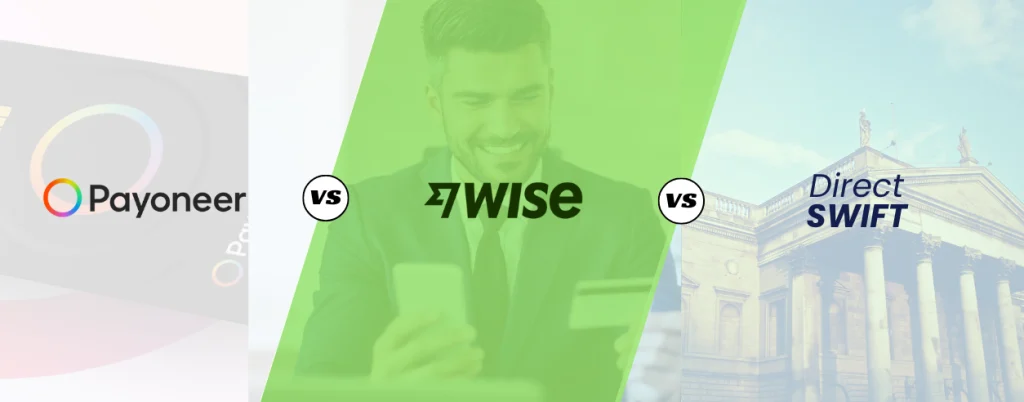If you’ve built your reputation on Upwork, every payout is more than money—it’s momentum. After decades straddling the worlds of export finance, forex, and long-form content, I’ve learned this simple rule: the difference between a good month and a great one is your landed INR—what actually hits your Indian bank after fees, spreads, and delays. This MOFU guide breaks down freelancer payment methods for Upwork earnings—Payoneer, Wise, and direct SWIFT—so you can choose the Upwork payment method that turns effort into INR with the least friction.
We’ll stay human and practical: explain how money moves, where costs hide, and how to write payment terms that make cash flow predictable. Then we’ll close by showing how a platform built for Indian service exporters (like you) can hard-wire speed, compliance, and fair FX into every payout.
Landed INR 101: what really decides your take-home
Think of landed INR as a three-variable equation:
- Rail & route (how the money travels)
- Local payout (Wise), marketplace wallet → local payout (Payoneer), or cross-border bank wire (SWIFT).
- Local payout (Wise), marketplace wallet → local payout (Payoneer), or cross-border bank wire (SWIFT).
- Cost structure (what it costs to travel)
- Fixed fees (transfer/withdrawal), percentage fees (platform take), and FX spread (the difference between mid-market and your rate).
- Fixed fees (transfer/withdrawal), percentage fees (platform take), and FX spread (the difference between mid-market and your rate).
- Time (T+0 to T+3)
- T+0/T+1 shrinks exposure to FX drift; T+2/T+3 stretches it. Faster payment settlement also means fewer operational delays and happier clients.
- T+0/T+1 shrinks exposure to FX drift; T+2/T+3 stretches it. Faster payment settlement also means fewer operational delays and happier clients.
Bottom line: A “cheap” route with a poor exchange rate can leave you with less landed INR than a slightly pricier route with a tighter spread. The payment settlement process is about speed and rate, not just headline fees.
The three paths most Upwork freelancers use
1) Payoneer (Marketplace wallet → INR)
How it works: Your Upwork earnings hit a Payoneer receiving account. You withdraw to your Indian bank via local rails.
- Speed: Typically T+1, often same-day if you hit cut-offs.
- Costs: Clear transfer fee plus an FX markup embedded in the conversion (convenience for a spread).
- Strengths: Terrific when you manage many small clients. Centralised dashboard, EBRC availability, smooth transaction reconciliation.
- Watch-outs: If you ignore FX, small spreads add up across a year.
Keyword fit: upwork withdrawal methods, freelancer payment, payoneer vs wise, wise vs payoneer for freelancers.
2) Wise (Local-rail payout → INR)
How it works: Client funds are collected abroad, converted near mid-market, and paid out to your Indian bank on domestic rails (IMPS/NEFT/RTGS).
- Speed: Frequently T+0–T+1 once Wise has the funds.
- Costs: Transparent fee + real, published currency exchange rates (minimal hidden spread).
- Strengths: Fast credits, crisp tracking, predictable landed INR, tidy documentation.
- Watch-outs: Ensure the sender funds the transfer using a fast method; late cut-offs can push you to T+1.
Keyword fit: freelance payment methods, wise vs payoneer for freelancers, Upwork payment method.
3) Direct SWIFT to India (Bank wire)
How it works: Upwork (or your client) pushes a wire through the banking network (correspondent banks) into your Indian account.
- Speed: Commonly T+2–T+3; faster if everything aligns, slower if it doesn’t.
- Costs: Explicit wire fees + intermediary deductions (lifting fees) + bank FX spread at conversion.
- Strengths: Universally accepted for bigger invoices; some enterprise clients insist on it.
- Watch-outs: Slower credits, opaque FX, more back-and-forth in the banking settlement process.
Keyword fit: international payment methods, payment settlement, banking settlement process.
“Wise vs Payoneer for freelancers” — the practical take
When peers argue payoneer vs wise, they often compare fees and stop there. The seasoned way is to compare total INR outcome at T+1:
- If you run recurring, mid-sized invoices to multiple clients, Payoneer’s daily sweep and centralisation can save hours each month.
- If you want near mid-market FX plus fast credits, Wise tends to land more INR per dollar—especially on larger tickets where spread matters.
- If a client’s AP insists on SWIFT, protect yourself with tighter payment terms (initiation window, OUR charges, acceptable FX slippage).
Illustrative landed INR (for ₹ planning)
Example only, to show mechanics—not a quote.
Scenario: USD 1,000 Upwork earnings to an Indian current account.
| Route | Fees (illustrative) | FX treatment | Typical speed | Landed INR signal |
| Wise | Transparent transfer fee | Near mid-market currency exchange rates | T+0–T+1 | Often highest landed INR for same-day/next-day credits |
| Payoneer | Low transfer fee + conversion spread | Platform FX (convenience for markup) | T+1 (often same-day) | Strong landed INR for small/medium tickets with admin simplicity |
| SWIFT | Sending + intermediary + receiving | Bank FX at conversion (opaque) | T+2–T+3 | Landed INR depends on spread; slower and costlier in aggregate |
Read it right: If timing is critical and you care about every basis point, Wise often wins. If simplicity across many clients is your north star, Payoneer is hard to beat. SWIFT is the “boardroom default”—use it when policy demands, but write smarter payment terms.

Hidden levers that change T+N (and INR)
- Cut-off choreography: Missing a sending bank’s cut-off by 10 minutes can add a full day. Agree on initiation windows in your Upwork payment method SOP.
- Funding method: Card or balance funding → faster; ACH/slow funding → later.
- Purpose codes & docs: Get RBI purpose codes right. Faster EBRC/FIRC means the payment settlement process ends with clean evidence.
- Reference hygiene: One invoice = one reference. Your books will thank you at month-end transaction reconciliation.
- FX posture: Free wires with poor rates aren’t free. Put acceptable spreads into your vendor policy.
Freelancer personas: choose your lane
- Solo freelancer (multiple small tickets):
Prioritise admin-light freelancer payment flows. Payoneer’s daily rhythm + dashboard can be a net win. - Specialist with fewer, larger milestones:
Speed + transparency usually beats convenience. Wise’s blend of T+0–T+1 and fair FX helps your landed INR. - Agency on Upwork (team payroll due):
You need predictability. Standardise a primary rail (Wise or Payoneer), keep SWIFT as a client-driven exception, and lock payment terms in SOWs.
FAQ the seasoned way
Q: Which payout method is fastest from Upwork? Is this phrased correctly?
Wise is often fastest to INR once funded, with many same-day outcomes. Payoneer hits a reliable T+1 cadence. SWIFT is the slowest.
Q: Can I mix rails?
Absolutely. Many pros use Payoneer for small recurring payouts and Wise for higher-value draws to optimise landed INR.
Q: Do I need EBRC/FIRC for freelance payment?
If your work classifies as export of services, keep EBRC/FIRC clean for GST and FEMA. Choose freelancer payment methods that generate compliant docs quickly.
Q: How do I write better payment terms on Upwork contracts?
Specify initiation window, who bears intermediary fees, and that FX shall not exceed an agreed spread vs mid-market on the value date.

Conclusion: Faster money, fair FX, clean evidence—how HiWi Pay makes it default
Wise showed freelancers that local rails can deliver T+0–T+1 with transparent pricing. Payoneer made Upwork withdrawal methods simple at scale. SWIFT still solves boardroom optics but costs you days and basis points. The message from the market is loud: Indian freelancers, agencies, and service exporters want speed, compliance, and honest FX in one stack.
That’s exactly where HiWiPay fits. Purpose-built for India’s service exporters and SMBs, HiWi Pay turns best practice into standard practice:
- More INR per payout
Consistently low FX mark-ups vs banks and generic players, with no hidden forex margins. Your freelancer payment lands fair and visible. - T+1 as muscle memory
Receive in ~24 hours on most corridors, with live status in a real-time view of the payment settlement process. - Compliance, baked in
RBI-aligned flows, guided export document suggestions (purpose codes, e-FIRC/e-BRC), and workflows that end audits before they begin. - Collect globally, settle locally
Free global virtual accounts so overseas clients pay “like locals,” then we settle to your Indian current account—ideal for modern freelance payment methods. - Books that reconcile themselves
Match payments with invoices automatically—line-item transaction reconciliation that trims hours off closing. - Operate without the branch
A secure, fast mobile app and one-to-one support when timelines are tight and templated replies won’t do. - Built by a payments veteran
Led by Dewan Neralla (who scaled Atom Technologies and NTT DATA Payments), HiWi Pay blends enterprise-grade rails with freelancer-friendly design.
If you’re weighing wise vs payoneer for freelancers (or the perennial payoneer vs wise) to maximise Upwork earnings, the smartest move is to institutionalise speed, fairness, and documentation—once. HiWiPay makes that your default: faster freelancer payment, cleaner compliance, and landed INR you can plan around.
Ready to move your Upwork payment method into the fast lane? Switch to HiWiPay and make T+1 your new normal.



